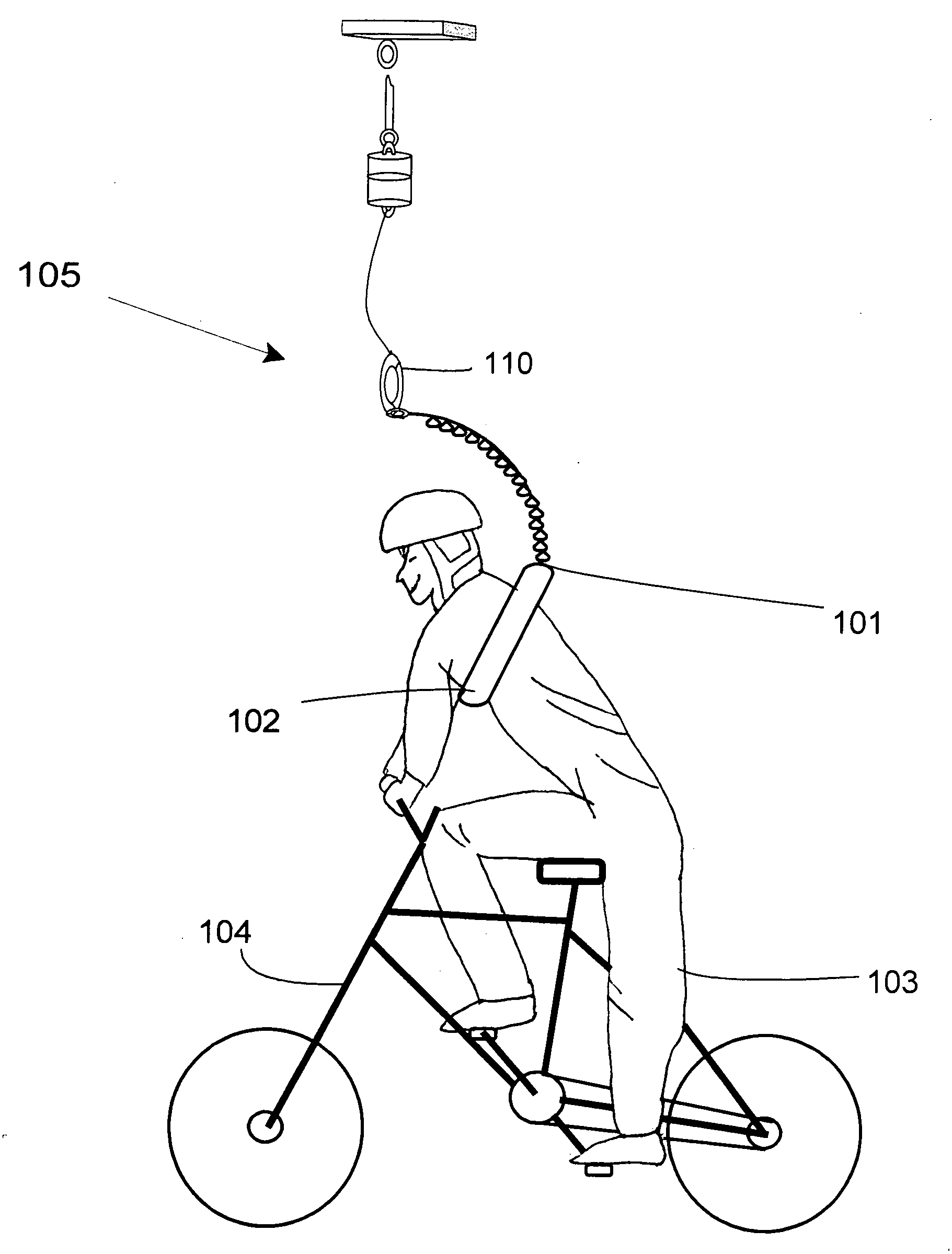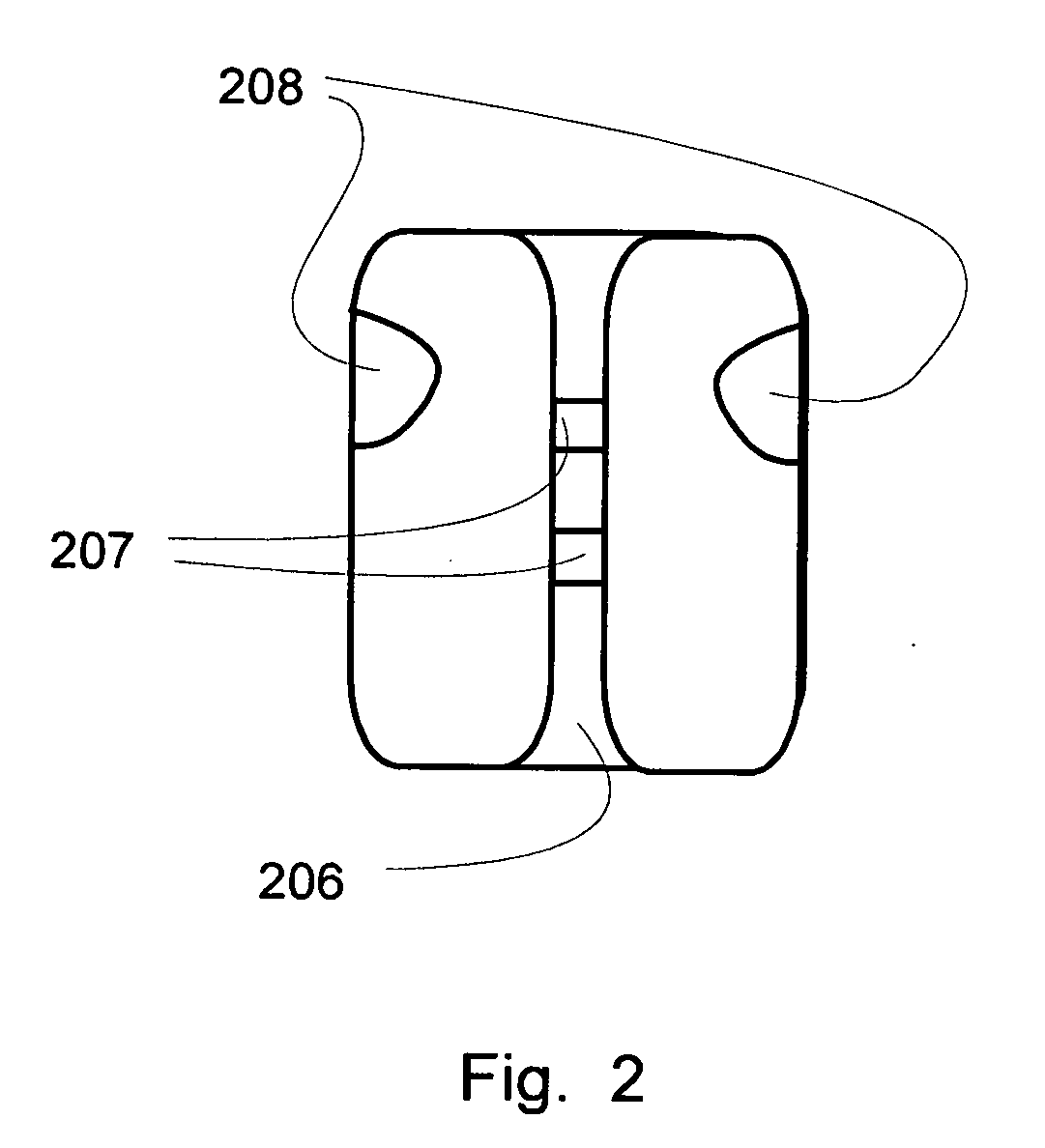Motion bicycle learning / handicap safety harness
a technology for bicycles and harnesses, applied in safety belts, sports equipment, cleaning equipment, etc., can solve the problems of less injuries, dramatic increases in bicycle related injuries, and increased bicycle usage, and achieve the effect of less injuries, but a more serious problem
- Summary
- Abstract
- Description
- Claims
- Application Information
AI Technical Summary
Benefits of technology
Problems solved by technology
Method used
Image
Examples
first embodiment
[0127]FIG. 2 indicates a front view of the invention with a human figure wearing the safety harness 102. The bicyclist 103 is shown wearing the invention having their arms protrude through the arm holes 208 of the safety harness 102. Rear connecting material 206 may be seen engaging the safety harness 102. The first carabineer 101 may be fastened, adhered and / or sewn to the rear connecting material 206. A front connector 207 may be seen at the front of the safety harness 102. The front connector 207 may connect the two arm holes 208 and safety harness 102 together thereby embracing the bicyclist 103 safely and securely.
[0128]FIG. 3 is an enlarged side view of a height adjustment device 300. The height adjustment device 300 consists of a reinforced backing material 311 and a reinforced material that has been looped 312 and may be fastened or sewn onto the reinforced backing material 311. An eyelet 310 may be fastened at the top of the height adjustment device 300 within the reinforce...
second embodiment
[0136]FIG. 9 is a side view of the invention, showing an indoor arrangement of the device of the invention. Building 902 has an elevated support structure / beam 904. This may be specially installed for use with the invention or it may be part of the building structure. It may be supported at or near the ends, or it may be cantilevered. It may be a metal beam, wooden, polymer, composite or other suitably sturdy construction.
[0137]Attachment 906 allows the rope 908 to be firmly attached to the beam 904. The attachment 906, rope 908, beam 904 and every other element of the linkage from the support structure to the rider's actual harness must all be very strong, strong enough to withstand the weight of a person at several Gs of acceleration and high values of “jerk” (the integral of acceleration). In embodiments, the rope 908, harness, etc may be all or partially extendable so as to deform and stretch before the point at which a person would sustain injury from a non-stretching device, h...
third embodiment
[0155]FIG. 7b is a front perspective view of the invention showing details of the support engagement loop.
[0156]Main line 802 and retrieval line 804 are actually physically different lines in this embodiment. This also allows use of different size / nature of lines. For example, a 9 millimeter nylon climbing rope is one preferred embodiment of the invention for the main line, but a much smaller line could be used for the retrieval line in this third embodiment. Nylon climbing rope is also carefully designed with the proper degree of deformation in case of accidents, this deformation softens a fall onto the rope but does not allow significant lengthening (which would itself cause safety issues).
[0157]The tubular harness may be subdivided internally to produce two “pockets”806 and 808 comprising the ends of the tube. Stitching may cause this subdivision. The harness material should be a sturdy fabric or composite such as nylons, polyesters, canvases and similar rugged materials.
[0158]In...
PUM
 Login to View More
Login to View More Abstract
Description
Claims
Application Information
 Login to View More
Login to View More - R&D
- Intellectual Property
- Life Sciences
- Materials
- Tech Scout
- Unparalleled Data Quality
- Higher Quality Content
- 60% Fewer Hallucinations
Browse by: Latest US Patents, China's latest patents, Technical Efficacy Thesaurus, Application Domain, Technology Topic, Popular Technical Reports.
© 2025 PatSnap. All rights reserved.Legal|Privacy policy|Modern Slavery Act Transparency Statement|Sitemap|About US| Contact US: help@patsnap.com



